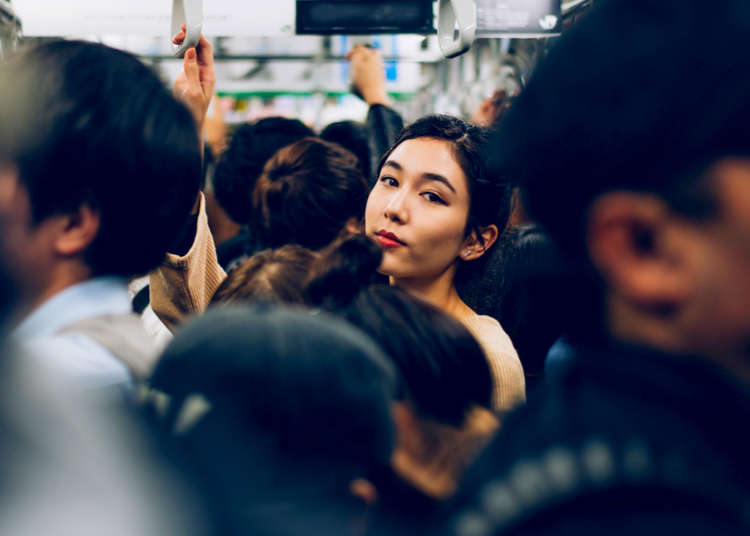
The trains in Tokyo during the rush hour are some of the most crowded in the country and for that matter almost anywhere else in the world, too. One feature that stands out on crowded Japanese trains is how quiet they are inside. Businessmen in suits and others appear silent and expressionless, which presents an eerie picture to unaccustomed foreigners.
If you travel in Japan, it is best to avoid riding the trains when they are crowded. On the other hand, you might be curious enough to want to see what it is like being a Japanese “corporate warrior” who must endure crowded trains almost daily and try riding one once during the rush hour. Here is a list of the 10 most crowded commuter train lines in the country!
What is the congestion rate for trains?
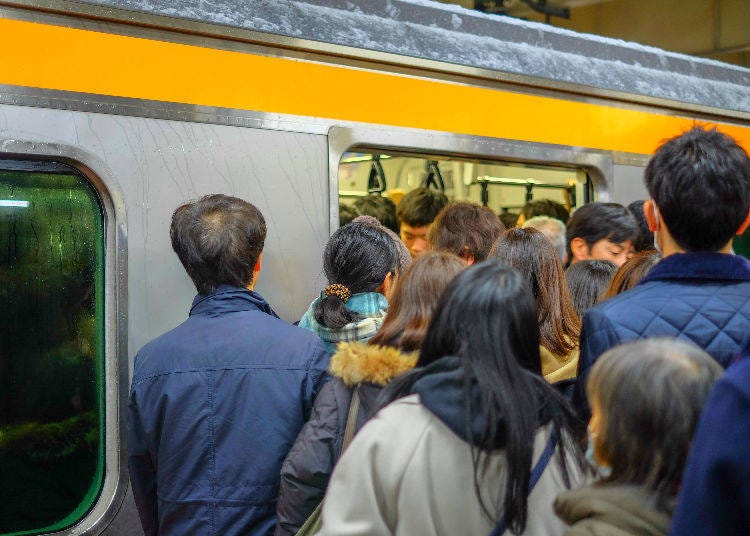
The Ministry of Land, Infrastructure and Transport defines the “congestion rate” as follows:
100% Congestion Rate: full passenger capacity (able to sit, stand and hold onto straps or handrails near doors.
150% Congestion Rate: Able to comfortably spread and read a newspaper.
180% Congestion Rate: Can read a folded newspaper without difficulty.
200% Congestion Rate: Quite crowded together, can barely read a magazine.
250% Congestion Rate: Unable to move hands or body and tend to be forced to bend at an angle when the train moves.
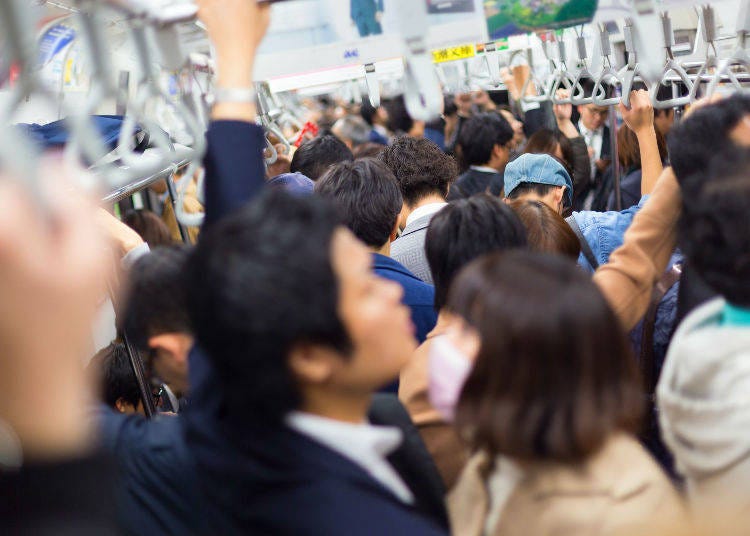
When the congestion rate exceeds 180% it is not possible for everyone to grab onto a strap. People standing are forced to move their feet to maintain their balance when the train sways and often they try hard not to lean into others around them.
Japanese line up neatly on platforms when awaiting the arrival of a train, but when boarding a crowded train, they cannot get on unless they push and squeeze themselves into any space they can find. When the train is so crowded that even then it is difficult to board, station platform staff will push passengers into the cars and hold them in while the doors shut.
There is an expression for this situation in Japanese called sushizume which means being squeezed together like sushi on a tray. China also has crowded trains like Japan and their expression for this is Xià jiǎozi shì de (boiled dumplings).
The following are the 10 lines with the worst congestion in Tokyo according to data in the 2016 Congestion Rate of Major Sections in the Tokyo Area.
(The congestion rate is based on the degree of congestion during an average hour.)
No. 10: 176% Congestion Rate – Keihin Tohoku Line
(Kawaguchi Station → Akabane Station)
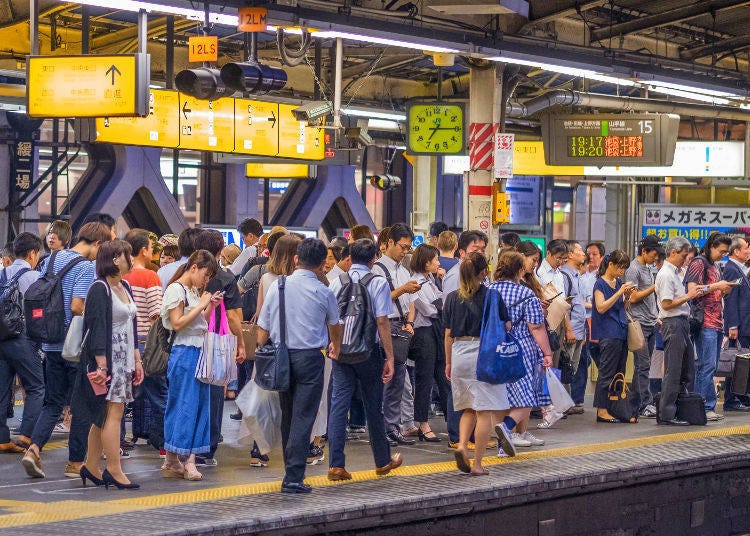
Section: Keihin Tohoko Line Kawaguchi Station → Akabane Station
Congestion Rate: 176%
Peak Time: 7:25 ~ 8:25 AM
No. of Passengers: 65,290
Starting Point and End Point of the Line: Omiya Station (Saitama Prefecture) ~ Yokohama Station (Kanagawa Prefecture)
Major Stations on the line and Tourist Spots: Nippori Station (Yanaka Ginza Shopping District) / Ueno Station, Okachimachi Station (Ameya Yokocho) / Akihabara (electronics district) / Tokyo Station (transfer for Shinkansen Lines) / Hamamatsucho Station (transfer for Tokyo Monorail) / Shinagawa Station (transfer for Shinkansen Line) / Yokohama Station (Chinatown)
Very crowded because passengers coming from Saitama Prefecture transfer to the JR Takasaki Line, JR Shonan Shinjuku Line, and JR Saikyo Line at Akabane Station. This line connects Omiya Station, the major station in Saitama Prefecture, with Yokohama Station, the major station in Kanagawa Prefecture, via Tokyo Station.
No. 9: 178% Congestion Rate – Chiyoda Line
(Machiya Station → Nishi Nippori Station)
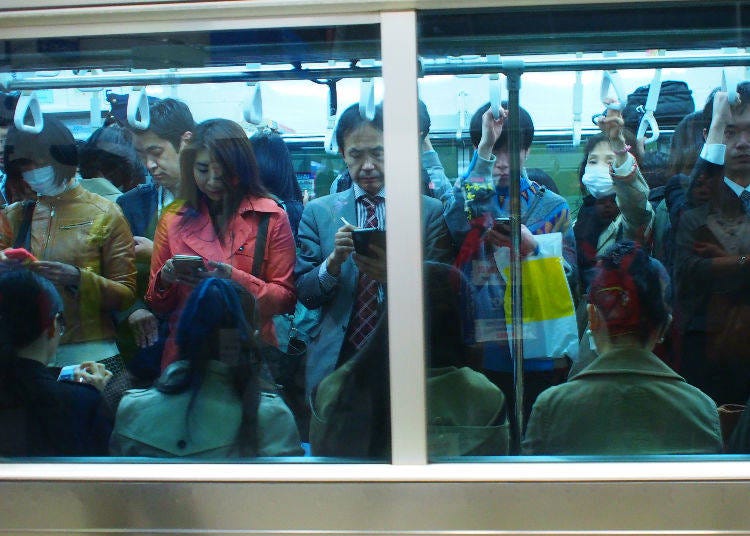
Section: Chiyoda Line Machiya Station → Nishi Nippori Station
Congestion Rate: 178%
Peak Time: 7:45 ~ 8:45 AM
No. of Passengers: 73,334
Starting Point and End Point of the Line: Ayase Station (Tokyo Metropolitan Area) ~ Yoyogi Uehara Station (Tokyo Metropolitan Area)
Major Stations on the line and Tourist Spots: Meiji Jingu Mae Station (Meiji Shrine) / Omotesando Station (Omotesando Hills) / Yushima Station (Yushima Tenshin) / Sendagi Station (Yanaka Ginza Shopping District)
The Keisei Main Line and Toden Arakawa Line run into Machiya Station. It is also very crowded because one station before it, Kita Senju Station, is connected to the Joban Line which brings commuters in from Chiba Prefecture, the Tobu Isesaki Line (Tobu Skytree Line) that brings commuters in from Saitama Prefecture, two suburban areas referred to as bed towns.
No. 8: 181% Congestion Rate - Sobu Line (Rapid)
(Shinkoiwa Station → Kinshicho Station)
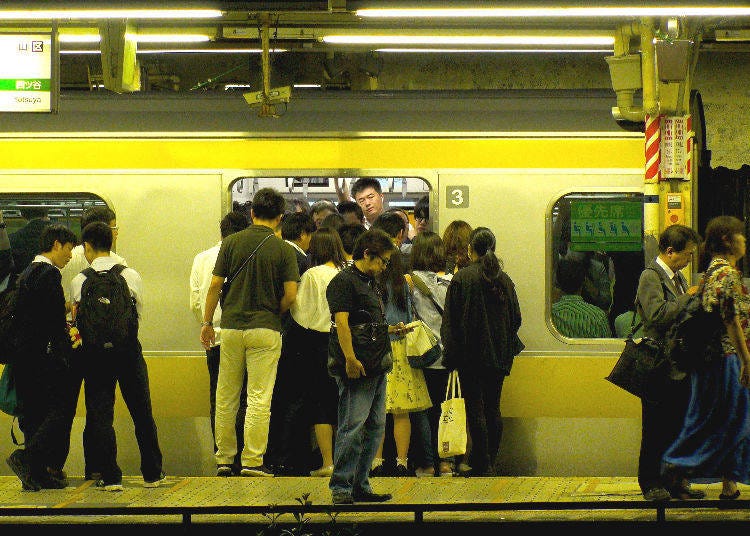
Section: Sobu Line (Rapid) Shinkoiwa Station → Kinshicho Station
Congestion Rate: 181%
Peak Time: 7:34 ~ 8:34 AM
No. of Passengers: 64,250
Starting Point and End Point of the Line: Chiba Station (Chiba Prefecture) ~ Mitaka Station (Tokyo Metropolitan Area)
Major Stations on the line and Tourist Spots: Ryogoku Station (Ryogoku Kokugikan) / Akihabara Station (electronics district) / Suidobashi Station (Tokyo Dome City) / Shinjuku Station (home appliance shops) / Kichijoji Station (Kichijoji Sun Road shopping district)
This is one of the most convenient lines for commuting into Tokyo from the Chiba area. The Rapid does not stop at as many stations as the Local train up to Kinshicho Station, so it greatly shortens the commuting time into the city however, as fewer people get off along the way, it tends to be more crowded.
No. 7: 184% Congestion Rate - Denentoshi Line
(Ikejiri Ohashi Station → Shibuya Station)
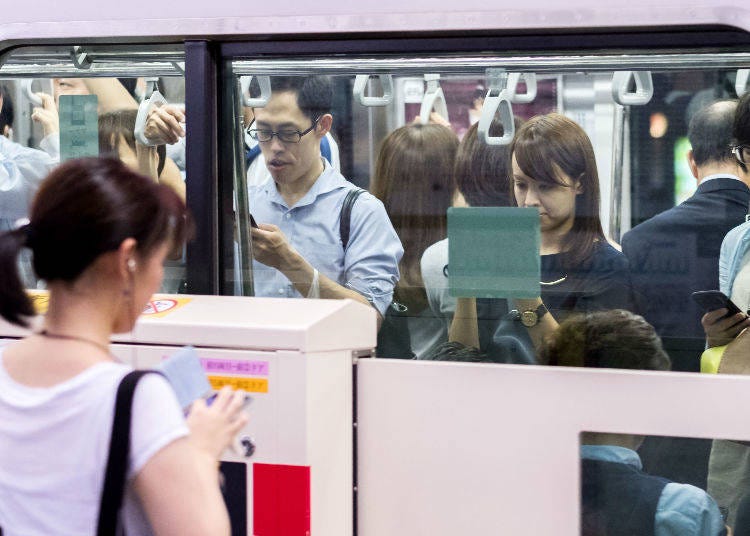
Section: Denentoshi Line Ikejiri Ohashi Station → Shibuya Station
Congestion Rate: 184%
Peak Time: 7:50 ~ 8:50 AM
No. of Passengers: 74,261
Starting Point and End Point of the Line: Chuorinkan Station (Kanagawa Prefecture) ~ Shibuya Station (Tokyo Metropolitan Area)
Major Stations on the line and Tourist Spots: Shibuya Station (Shibuya 109, etc.)
The Denentoshi Line passes through popular residential areas in Setagaya-ku and Machida-shi as it makes its way into to the city from Kanagawa Prefecture in the west, but as few people get off and more get on as the train approaches Shibuya it becomes very crowded.
No. 6: 184% Congestion Rate - Tokaido Line
(Kawasaki Station → Shinagawa Station)
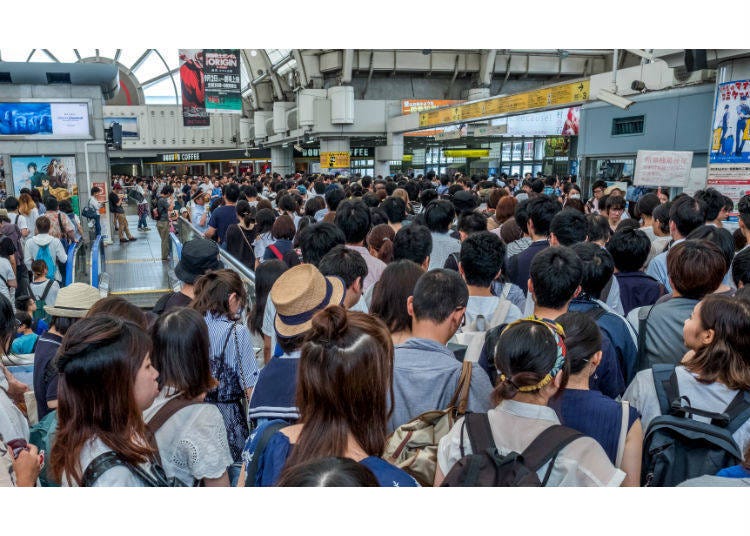
Section: Tokaido Line Kawasaki Station → Shinagawa Station
Congestion Rate: 184%
Peak time: 7:39 ~ 8:39 AM
No. of Passengers: 64,400
Starting Point and End Point of the Line: Atami Station (Kanagawa Prefecture) ~ Tokyo Station (Tokyo Metropolitan Area)
Major Stations on the line and Tourist Spots: Tokyo Station (transfer for Shinkansen Lines) / Shinagawa Station (transfer for Shinkansen Line) / Yokohama Station (Chinatown) / Yugawara Station (Yugawara hot springs) / Atami Station (Atami hot springs)
Three lines run between Kawasaki Station and Shinagawa Station; the Tokaido Line, Keihin Tohoku Line, and Keikyu Main Line. It takes the Tokaido Line about 8 minutes and the Keikyu Main Line (Limited Express) about 14 minutes. That 6-minute difference in the morning makes a big difference and makes the Tokaido Line more popular.
No. 5: 188% Congestion Rate - Chuo Line (Rapid)
(Nakano Station → Shinjuku Station)
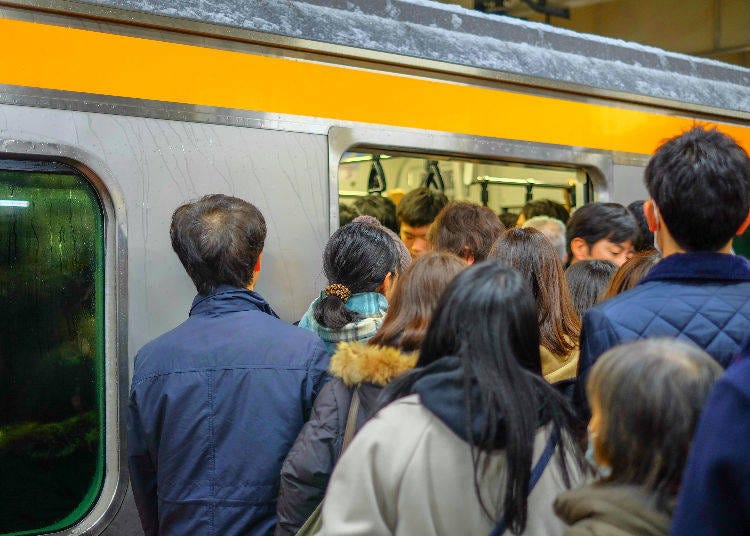
Section: Chuo Line (Rapid) Nakano Station → Shinjuku Station
Congestion Rate: 188%
Peak Time: 7:55 ~ 8:55 AM
No. of Passengers: 83,220
Starting Point and End Point of the Line: Takao Station (Tokyo Metropolitan Area) ~ Tokyo Station (Tokyo Metropolitan Area)
Major Stations on the line and Tourist Spots: Takao Station (Mt. Takao) / Kichijoji (Kichijoji Sun Road shopping district) / Shinjuku (home appliances shops) / Tokyo (transfer for Shinkansen Lines
This is one of the train lines in the western part of Tokyo having the most frequent use. It services the most passengers, more than 80,000, among the top 10 ranked lines.
No. 4: 191% Congestion Rate - Yokosuka Line
(Musashi Kosugi Station → Nishi Ōi Station)
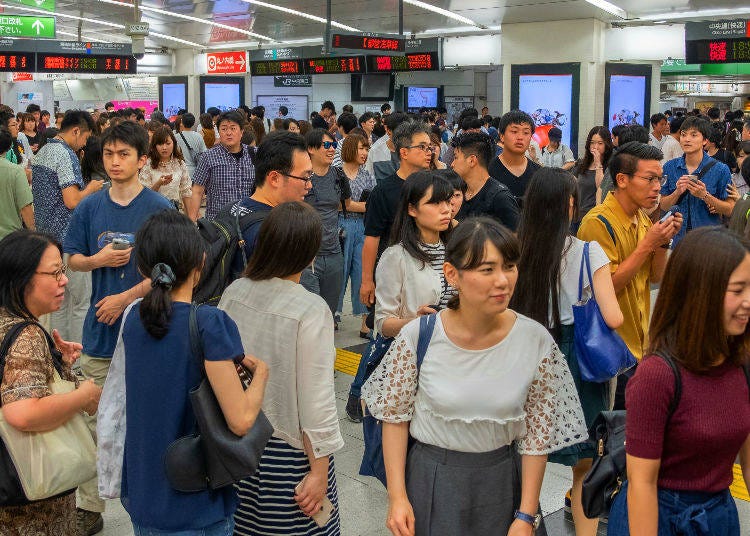
Section: Yokosuka Line Musashi Kosugi Station → Nishi Ōi Station
Congestion Rate: 191%
Peak Time: 7:26 ~ 8:26 AM
No. of Passengers: 35,550
Starting Point and End Point of the Line: Tokyo Station (Tokyo Metropolitan Area) ~ Kurihama Station (Yokosuka City, Kanagawa Prefecture)
Major Stations on the line and Tourist Spots: Tokyo Station (transfer for Shinkansen Lines) / Shinagawa Station (transfer for Shinkansen Line) / Yokohama Station (Chinatown) / Kamakura Station (Kamakura Great Buddha) Kurihama Station (Kurihama)
Many people who commute from Kanagawa Prefecture use this line. In recent years the area around Musashi Kosugi Station has become a popular bed town in Kanagawa Prefecture.
No. 3: 192% Congestion Rate - Odakyu Odawara Line
(Setagaya Daita Station → Shimokitazawa Station)
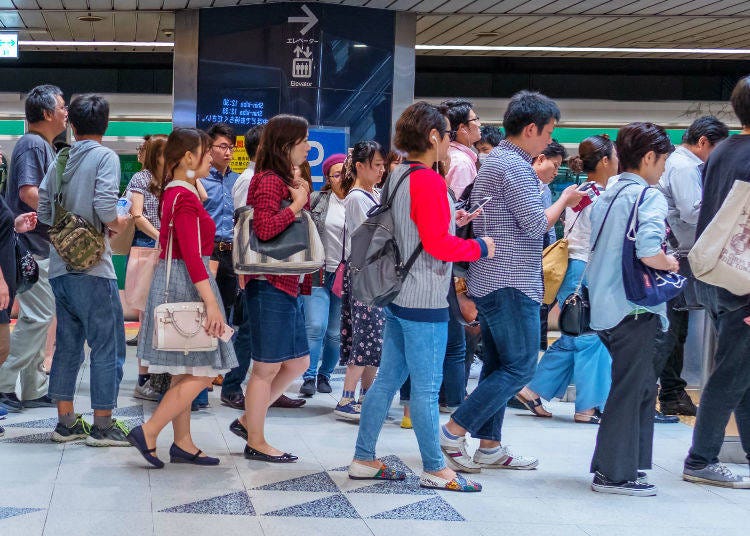
Section: Odakyu Odawara Line Setagaya Daita Station → Shimokitazawa Station
Congestion Rate: 192%
Peak Time: 7:46 ~ 8:48 AM
No. of Passengers: 73,816
Starting Point and End Point of the Line: Odawara Station (Kanagawa Prefecture) ~ Shinjuku Station (Tokyo Metropolitan Area)
Major Stations on the line and Tourist Spots: Shimokitazawa Station (transfer for Keio Inokashira Line going to Shibuya) / Shinjuku Station (home appliances shops)
This line is crowded with commuters coming in from Kanagawa Prefecture and commuters living in residential areas of Setagaya-ku.
No. 2: 198% Congestion Rate - Sobu Line
(Kinshicho Station → Ryogoku Station)
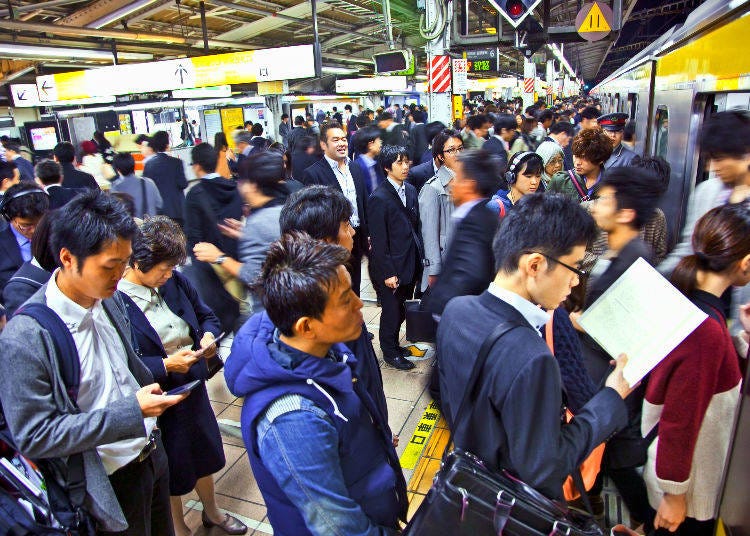
Section: Sobu Line Kinshicho Station → Ryogoku Station
Congestion Rate: 198%
Peak Time: 7:34 ~ 8:34 AM
No. of Passengers: 76,370
Starting Point and End Point of the Line: Chiba Station (Chiba Prefecture) ~ Ochanomizu Station (Tokyo Metropolitan Area)
Major Stations on the line and Tourist Spots: Ryogoku Station (Ryogoku Kokugikan) / Akihabara Station (electronics district) / Suidobashi Station (Tokyo Dome City) / Shinjuku Station (home appliances stores) / Kichijoji Station (Kichijoji Sun Road shopping district
The Toei Hanzomon Line connects at Kinshicho Station and the Toei Ōedo Line connects at Ryogoku Station. Commuters coming in from Chiba Prefecture and Saitama Prefecture meet here causing the heavy congestion.
No. 1: 199% Congestion Rate - Tozai Line
(Kiba Station → Monzen Nakacho Station)
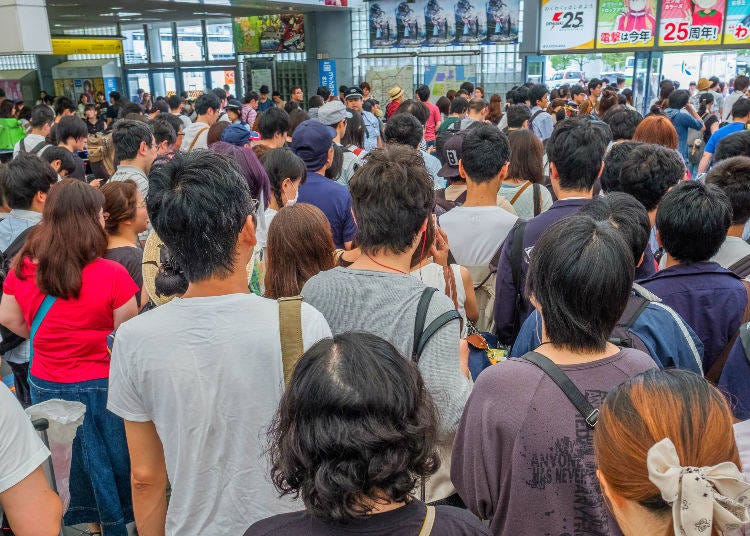
Section: Tozai Line Kiba Station → Monzen Nakacho Station
Congestion Rate: 199%
Peak Time: 7:50 ~ 8:50 AM
No. of Passengers: 76,4747
Starting Point and End Point of the Line: Nishi Funabashi Station (Chiba Prefecture) ~ Nakano Station (Tokyo Metropolitan Area)
Major Stations on the line and Tourist Spots: Nakano Station (Nakano Broadway) / Kudanshita Station (Cherry blossoms at Chidorigafuchi)
This section has a large number of commuters coming into Tokyo from bed towns in Chiba Prefecture. It is also possible to transfer to the Tokyo Metro Tozai Line and Toei Ōedo Line at Monzen Nakacho Station.
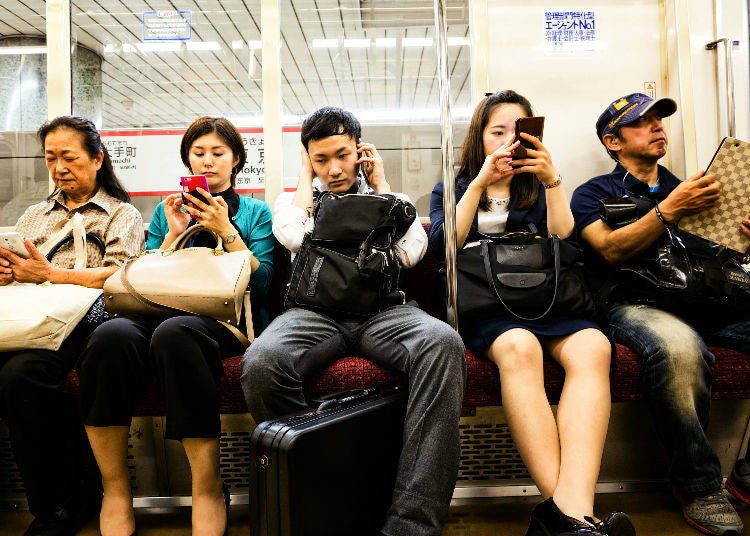
The average congestion rate for the 31 sections of Tokyo according to Ministry of Land, Infrastructure and Transport statistics is 165%. Until the 1980s the average congestion rate was more than 200% so compared to then the crowding has eased up a bit. The peak period of congestion for any of the lines is around 7:30 ~ 8:50 AM. The ranking of the top four most congested lines has been unchanged since 2014. Much of the crowded sections have commuters from bed towns in Chiba, Saitama, and Kanagawa prefectures who commute to Tokyo for business and school.
*Prices and options mentioned are subject to change.
*Unless stated otherwise, all prices include tax.
Popular Tours & Activitiess
-
Ad

Walk in the Footsteps of Believers: A 4-Day Pilgrimage Across Goto Islands, Nagasaki Prefecture
by: Yohei Kato
-

2025 Autumn Colors Report: Kurobe Gorge Nearing Peak
by: Timothy Sullivan
-

LaLaport TOKYO-BAY North Building Now Open: Shop, Dine & Enjoy Events at LaLa arena, Just 2 Stops from Disney
by: Wemmy Chau
-

Black Friday 2025: These Are THE Japan Travel & Shopping Deals to Check Out
-

Get Ready to Catch 'Em All! First Ever Permanent Outdoor Pokémon Park Opening Near Tokyo!
-

2025 Japan Autumn Color Report: Tokyo's Ginkgo Trees Starting to Glow
by: Timothy Sullivan
Inspiration for Accommodations
-

Enjoy Mt. Fuji from the Comfort of Your Room! Recommended Ryokan with Mt. Fuji View
-

Stay Near the Cherry Blossoms! Hotels for Cherry Blossom Viewing in Tokyo
-

Family-Friendly Hotels with Free Shuttle to Disneyland: Convenient Access for a Magical Stay
-

Top Ranked Hakone Hotels with Mt. Fuji View: Enjoy Stunning Scenery from Your Private Space
-

Convenient Tokyo Hotels with Airport Shuttle: Ideal for Families and Heavy Luggage
-

Stunning Tokyo Tower View Hotels: Enjoy Spectacular Scenery from Your Private Space
-

Convenient Asakusa Hotels with Kitchens: Ideal for Extended Family Visits
-

Experience Luxury: Hakone's 10 Best Five-Star Accommodations
-

Enjoy Mt. Fuji Autumn Leaves! Top Hotels Near the Popular Autumn Leaves Corridor
-

Experience Hakone Fall Foliage from Your Room with Stunning Views
-

Get Japanese miscellaneous goods in Kishimojin and Waseda!
-

Autumn in Japan 2025: Fall Foliage Forecast & Where to Enjoy the Colorful Leaves (+Tour Info)
-

Japan's Drinking Culture is so Different! Why Are There So Many 'Standing Bars' in Japan?
-

Ueno Station Area Guide: Fun Ways to Explore Tokyo's Popular Destination (Area Map & Sightseeing Tips)
-

6 Surprisingly Cheap Things in Japan
-

'Stop With the Personal Questions!' - Things That Shocked British People When Visiting Japan
- #best ramen tokyo
- #what to buy in ameyoko
- #what to bring to japan
- #new years in tokyo
- #best izakaya shinjuku
- #things to do tokyo
- #japanese nail trends
- #what to do in odaiba
- #onsen tattoo friendly tokyo
- #daiso
- #best sushi ginza
- #japanese convenience store snacks
- #best yakiniku shibuya
- #japanese fashion culture
- #best japanese soft drinks



















